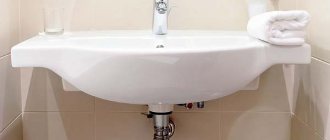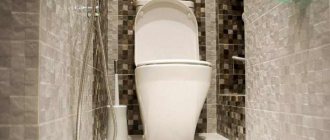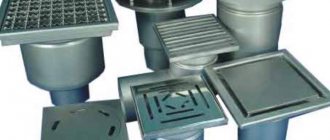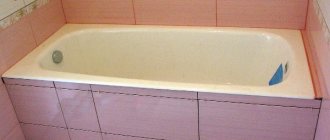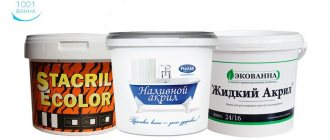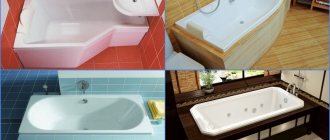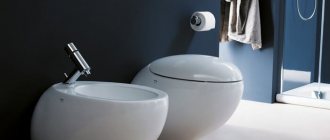The bath is the central element of every bathroom, without which it is impossible to imagine living in a modern, comfortable home. Fortunately, hardware stores offer a wide range of plumbing fixtures for every taste or income, from cast iron, steel to acrylic.
To ensure the convenience of using a washing container, it is important not only to choose a high-quality container, but also to install it correctly. In this article we will tell you what the height of the bathtub should be from the floor according to generally accepted building codes.
Types of baths
There is a wide range of bathtubs on the sanitary equipment market. Each buyer can purchase a model he likes, made of steel, cast iron, acrylic, or a new sanitary ware product - a quarry product. You can also choose the bathtub volume, width and length. The choice depends on the size of the bathroom, personal preferences and financial capabilities of the consumer.
The steel option is considered the most affordable. This bathtub is light in weight and does not cause problems during transportation. The use of steel as a manufacturing material allows the product to be given different geometric shapes. But the service life of such a bath is short, since it does not sufficiently withstand mechanical stress. The product does not hold heat well and makes a lot of noise.
The classic tank is a heavy tub made of cast iron. This product is characterized by reliability and durability. It does not have a wide variety of shapes, but can have an original design. Water poured into a cast iron bath retains heat for a long time. Prices for these products are several times higher than for steel products.
In recent years, the types of tanks described above have been replaced by acrylic bathtubs, which have become very popular. They are lighter in weight, but at the same time retain heat excellently. High-quality acrylic products can last at least 10 years. The height of the acrylic bathtub from the floor is standard.
The advantage of this product is a large selection of colors and shapes. But the presence of numerous intricate lines leads to a decrease in strength indicators. Since there are no pores on the surface of acrylic, pathogenic microorganisms do not multiply in such a bath.
A pleasant novelty on the plumbing equipment market is products made from the composite material quaril, which includes:
- quartz;
- acrylic;
- polymer additives.
The long service life of these baths justifies their high cost. Quaril is a hygienic material with a hard surface and resistance to ultraviolet radiation. Models made from it are heavier than acrylic products - their weight reaches 50 kilograms. The cost of quaril baths is quite high, since they are produced exclusively in Europe.
How to install, install and connect - instructions
Renovating a bathroom with replacing plumbing always requires an answer to the question – what, where and how to install it. First of all, it is necessary to resolve the issues of rational water supply and sewerage.
Next, you need to level the vertical and horizontal surfaces for subsequent finishing. In this case, you must remember to arrange slopes in the direction of the drainage grate.
The easiest way to install a bathtub is made of cast iron. Due to its large mass, it is the most heat-resistant and silent when filled with water. It must be installed strictly parallel to the floor in compliance with the installation height requirements described above.
Its significant weight can be considered an undoubted advantage, since thanks to it the bath remains stable during use and does not require additional measures to strengthen it at the site of use.
The most popular in terms of price-quality ratio are steel bathtubs with an enameled inner surface. They are much lighter than cast iron and therefore easier to install.
How to implement sound insulation and reduce heat transfer of steel products with an enameled inner surface
But their significant disadvantages are two features. The first is noise when filling with water, the second is rapid cooling due to the high thermal conductivity of the material. To get rid of such troubles, proceed as follows:
- The bathtub directly at its location is tipped upside down.
- The surface of the bottom and sides are thoroughly cleaned of dirt and degreased with acetone.
- Polyurethane foam is applied to the surface of the sides and bottom and carefully leveled.
- Polymerization of the applied layer occurs within 24 hours.
Further, if necessary, strongly protruding fragments can be leveled with a sharp knife.
This treatment of the outside of the font significantly increases its heat resistance and reduces the noise level when filling.
The weakness of the body of such a vessel due to deformation during filling and use also deserves attention and additional refinement. It is common practice to install such containers on an additional brick foundation that compensates for the load on the bottom.
In this case, the height of the bathroom 170 x 70 from the floor is standard and is 70 centimeters.
Installation instructions
Watch the video
Installing a bathtub is a responsible operation that is best entrusted to a specialist or performed independently under his guidance. In this case, you must adhere to the following rules:
- In accordance with the requirements of SNiP, the bathtub must be installed on a perfectly flat horizontal surface. The load-bearing characteristics of the finishing material of the floor must correspond to the weight characteristics of the font plus the mass of poured water. In particular, for cast iron vessels it is better to use porcelain stoneware tiles.
- To protect the bathtub during installation, it is installed last, when the main finishing work has already been completed.
- It is necessary to determine in advance its location, including the design of the supporting device. The installation method is taken into account - on a foundation, a metal frame or directly on standard legs.
- In some cases, when using a metal bathtub, standard legs do not provide performance characteristics. Over time, where the legs rest on the bottom, the enamel may crack and peel. Therefore, housings made of thin metal sheets must be installed on a special support, which increases the support area.
- Of course, the standard height of the bathtub from the floor is maintained.
Features of installation of acrylic products
The use of acrylic bathtubs has its own characteristics. A body made of this material can deform quite significantly when filled with water and undergoing procedures.
Therefore, such products are installed with support on a specially made metal frame. Load perception points are located in such a way as to support the font not only through the bottom, but also through the upper flanges.
However, the most popular way to install a bathtub is to install it on a brick foundation. Moreover, the masonry is carried out in such a way that the height of the acrylic bathtub from the floor complies with the standard and is no more than 70 centimeters. Deviation is acceptable, but only in the direction of decreasing this indicator.
The supporting base for an acrylic bathtub is formed with subsequent consideration of decorative finishing.
SNiP standards
Installing a hot tub is a complex process that requires compliance with technical standards. First of all, you should adhere to the standard height of installation of the bathtub from the floor. SNiP, regardless of its size, recommends 60 centimeters.
In addition, the installation height of the bathtub from the floor is not affected by its location. The product can be placed against the wall when the room is small or in the middle if it is quite spacious. The main requirement in this case is the presence of free space around the bath, which should be at least 1 meter.
SNiP also normalizes the height of the threshold in the room - it cannot exceed 3 centimeters. In such a parameter as the standard bath height, exceptions are allowed. In children's and medical institutions, these products are raised to a distance from the floor surface, which is 10 centimeters less than the standard.
The installation height of the bathtub, equal to 60 centimeters, is not a mandatory parameter for home conditions. Since the height of all family members is different, a deviation in size up or down by 10 centimeters is considered acceptable. It is important that it is comfortable to get in and out of the bath.
Prescribed standards
For this case, SNiP has a special provision that indicates the exact height of the bathtub from the floor. After all, ease of use and, more importantly, safety directly depend on the choice of the optimal height of the plumbing fixture. The height depends on the depth of the bowl and the height of the legs or supports. Depending on the models, the depth of the bowl can vary from 50 to 60 cm.
If we talk about the standards prescribed in SNiP, they are as follows:
- The height of the bathtub from the floor surface should be exactly 60 cm. This is the best option for an adult. This distance guarantees safety when immersing in and exiting the bath, as well as ease of use.
- If the bathtub is not mounted flush against the wall, then the distance from the plumbing fixture to the wall should be at least 70 cm. This way a person can easily walk to the equipment.
- Regardless of the size of the bowl, the bottom of a regular bathtub must be raised above the floor by at least 15 cm during installation. This is done to install and connect the siphon located at the bottom of the product.
- As for installing the bathtub itself in its place, it does not need to be installed at an angle. It is enough to install it strictly horizontally. The required slope to the drain hole in it has already been made in advance at production.
It turns out that the standards indicate an optimal height of 60 cm. But, I would like to note that this is not a law, but a recommendation. For example, if we talk about children's or health care institutions, then the height of the bathtub can be reduced to 50 cm.
True, there are other permissible deviations that are important to consider.
General installation rules
The height at which the bathtub is installed from the floor must be determined in advance. To do this, you need to know the height of the shortest person in the family.
The installation height of the bathroom is influenced by the type of wall cladding in the room. If it is a tile, then you need to know the dimensions of its sides. On an area of 60 centimeters you can lay 2 - 3 rows of facing material.
Correctly performed installation of the hot tub, taking into account the height at which the bathtub is installed, provides for:
- Its strictly horizontal location is controlled using a level, which is set along the side located near the wall.
- The angle between the side and the wall should be 90 degrees. Therefore, for installation, a large triangle will be required, allowing for constant verification of compliance with this condition.
To make it easier to ensure horizontal sides, metal spacers are used in the form of plates measuring 100x100x5 millimeters. Their presence under the supports is mandatory if the product is mounted on a base with less hardness compared to the screed, which can be laminate, parquet or wooden flooring.
In this case, the tank will sag during operation if stiffeners are not applied. When deciding at what height from the floor to install the bathtub, it is necessary to take into account that a siphon will be located under its bottom. For its stable operation, a free space of approximately 150 millimeters is required.
Jacuzzi installation rules
Large bathrooms allow you to install a Jacuzzi. This is a special type of plumbing fixtures, equipped with hydromassage and other additional equipment. Such models are not recommended for use in apartment buildings due to their heavy weight and installation complexity. But for a private cottage they will be an excellent choice.
Before installation, filters are installed in the water supply system. All sockets to which the equipment will be connected must have class 4 protection and grounding. It is important to organize proper ventilation indoors.
Installation of a jacuzzi is divided into several stages:
- Housing installation. Supports are supplied complete. It is carried out similarly to the installation of a conventional acrylic bathtub.
- Connection to the water supply and sewerage system.
- Electrical connection.
- Test run, eliminating any errors, checking the functionality of all systems.
It is difficult to carry out all the work on your own. To guarantee high-quality installation and complete safety, it is better to seek help from professionals.
Installation of cast iron products
It is very important to choose the height of a cast iron bathtub before installing it, since it is heavy, and it will be difficult to adjust this parameter later. Bowl legs made of this alloy are usually made solid, featuring an original design.
The classic option is a cast iron bathtub located on ornately shaped supports with ornaments or engravings. There are models mounted on “lion paws” or legs in the form of a vine or graceful petals. The supports must be rigidly attached to the body. To fix them, tightening bolts or metal wedges are used.
If the model comes with non-adjustable stands, then to adjust the height of the bathtub from the floor, they are cut and then sanded. The surface on which the tank is placed must be as smooth and durable as possible. If the floor is not rigid enough, metal pads with a diameter of more than 5 centimeters and a minimum thickness of 5 millimeters must be placed under the legs.
If the floor surface is slippery, the bowl supports are fixed with waterproof polymer adhesive. When you need to adjust the height of a cast-iron bathtub from the floor with adjustable legs, use special screws and then tighten them with locking nuts (read: “Correct installation of a cast-iron bathtub - a step-by-step guide”).
Modern products on one of the legs have a special eyelet designed for connecting a grounding wire. When this element is present, you need to strip the insulation so that the cable fits as tightly as possible to the connection point. Then all that remains is to connect the conductor using a bolt.
Old models do not have such an ear, so they cannot be grounded using a simplified scheme. The fact is that when they were used, grounding was ensured by connecting the bathtub to the ground using a cast-iron water supply system, but after replacing cast iron with plastic, it stopped functioning.
When installing, to adjust the height of a cast-iron bathtub with legs and the parallelism of the sides of the font, use a building level. If the product needs to be moved in the future, do this by tapping the supports located close to the points of movement.
What types of baths are there?
There are models of various shapes, colors, and sizes on the market. The key selection criterion is the material from which the product is made. There are six main types of baths.
| Image | Type | Description |
| Cast iron | A classic option whose popularity has not waned for several centuries. Cast iron bathtubs are highly durable and reliable. Water is poured into them almost silently and retains its temperature for a long time. In production, cast iron is used that complies with GOST 4832-95. The main disadvantage of the product is its heavy weight, from 100 to 150 kg. This complicates the transportation and installation of the bath. | |
| Steel | Their production peaked in the 70s, but they are still produced today. The main advantages of a steel bathtub are its low price and light weight. This design is easy to install, it does not require special care, and washing it takes a minimum of time. The disadvantage is low strength. Under the influence of heavy weight or strong impact, the bowl bends, which leads to the formation of cracks in the enamel. Water is poured into such a container noisily and cools quickly if it is not covered with sound insulation. Additional equipment, such as hydromassage, cannot be installed in a steel product, since its walls are too thin. | |
| Acrylic | This material appeared several years ago and quickly gained popularity. An acrylic bathtub is lightweight, has a long service life, and maintains the water temperature for a long time. Acrylic has antibacterial properties, which, on the one hand, allows you to get rid of pathogenic microflora, and on the other hand, negatively affects the health of human skin. The product requires special care. It can only be washed using special non-aggressive products. | |
| Quarilovaya | Such models appeared on the market relatively recently. They are made from acrylic mixed with quartz sand. This allows you to achieve high strength and wear resistance. The performance characteristics of the products do not differ from analogues made from pure acrylic. But the quaril model will cost 30% more. | |
| Ceramic | Elite products are made from ceramics. They are characterized by absolute smoothness and clear lines. The water in such a bowl retains its temperature for a long time. The material is wear-resistant, easy to clean, and does not form limescale. The only drawback of the design is its high price. | |
| Stone | They are made from artificial or natural stone. In the first case, aluminum trihydrate is used in a mixture with stone chips and binders. Such structures are heavy and can release chemical compounds. They are durable, have low thermal conductivity, and can be equipped with additional equipment. Products made from natural granite or marble have similar characteristics. They are more expensive, but are environmentally friendly. |
There are rare types: glass, wood, copper. They are made to order for designer interiors.
Today, bathtubs are produced in round, rectangular and oval shapes. Experts consider corner models ideal from the point of view of space optimization.
Adjusting the height of a steel bathtub from the floor
Unlike a product made of cast iron, a steel bowl cannot be placed in the middle of the room; it must be adjacent to the wall. Before leveling it relative to the standard height of the bathroom from the floor, the walls should be tiled.
Of the available methods for fixing steel products, the most reliable and safe is the use of supports with self-adhesive pads. If you install legs with tightening bolts, the enamel may peel off when tightening the fasteners or during operation.
Regulating, self-adhesive, following the contour of the bottom of the font, the supports for adjustment are always paired, have a slight deflection at the base and a channel shape. Screws for changing the height of a bathtub with legs from the floor are equipped with plastic tips.
Short legs with long bolts are considered especially reliable for steel products. The bathtub is moved to straight walls without finishing, having previously impregnated them with a moisture-proofing agent. Before installing a new product and adjusting the standard height of the bathtub with legs from the floor, try on self-adhesive supports at the points of contact with the bowl.
The first of them is placed at a distance of about 30 millimeters from the drain hole, and the second - on the opposite side on a flat base. The contact points are first wiped with solvent or alcohol. The pad is slightly warmed up using a hair dryer.
Then, before setting the standard height of the bathtub from the floor, remove the protective film, place the supports according to the markings and press them tightly. Place clamping nuts on the adjusting studs and drive them all the way into the plastic tips. The nuts are moved to the tips. Next, the assembled unit is attached to the supports.
After the plumbing fixtures are installed, they are pre-aligned to the level and according to the standard height of the bathroom. Then they make precise adjustments using 4 wedges made of wood. They are driven between the side and the walls so that the edges protrude slightly. The side is glued with paper tape. The resulting gap is foamed using a balloon with a narrow nozzle.
When the polyurethane foam has hardened, the wooden wedges are dismantled using pliers. Excess foam is cut off and the play is eliminated by unscrewing the adjusting pins.
Next, they begin finishing. To do this, cover the bowl with film and finish the walls and floor with tiles. The legs are pulled by hand so that the bathtub fits tightly against the wall. The nuts are tightened by twisting them close to the supports.
To check whether the height of the bathtub from the floor is set correctly according to the standard, measurements are taken at 4 points from the floor surface to the side. The difference between them cannot exceed 4 millimeters. If this condition is not met, the adjustment is made again.
Features of installing a steel bath
The peculiarity of installing metal bathtubs is that they can only be placed near the wall. Otherwise, the product will not be safe to use. If there is a small gap between the wall and the product, it is sealed with sealant or a special border is used.
When installing the bathtub on legs secured with bolts, make sure that when tightening the fasteners, the enamel does not peel off. It is recommended to give preference to self-adhesive supports. They are securely fixed and do not damage the surface of the product.
It is easy to ensure a standard height of plumbing fixtures by making a brick podium for it. Areas of the structure that come into contact with plumbing fixtures are covered with waterproofing material. On the wall side, the edge rests on a wooden beam.
Deviations from standards, what height is acceptable
There are some deviations between building codes and regulations. The reference books indicate that the standard height for children's institutions and health care institutions should be 500 mm. It should be understood that all the figures given are not final, and deviation from them will not lead to undesirable consequences.
Height of the rectangular bathtub Aurora
Each owner has the right to set the optimal height and distance for himself based on personal preferences and maximum comfort. Only self-adjusted tests can make it clear what the ideal height should be. Ultimately, this is the only way that bathing procedures can bring maximum pleasure.
Acrylic sizes and shapes
Acrylic is a durable, chemically neutral polymer with a wide range of applications. They also make baths from it. Moreover, acrylic bathtubs come in a variety of shapes and sizes. They come in round, oval, angular, and complex shapes (in the form of a bean, for example). The walls may not be straight, but rounded, with smooth bends. The bottom may have steps; there are often seats, recesses, armrests and other “excesses” that make operation more convenient. Various sprayers and nozzles for hydromassage are built into an acrylic bathtub.
Advantages and disadvantages
Acrylic is a much less heat-intensive material than steel and cast iron. This means that it heats up faster. And this is another plus. The next positive quality is that it is lightweight. A bathtub of any size made of acrylic can be easily carried by one person. Another positive point: the size of the acrylic bathtub can be ordered. The material is plastic, it can be given any shape, and the technology is such that you can make a container both large and small.
Now about the disadvantages. The walls of the acrylic bathtub are thin and bend under load. Not the most pleasant feeling. Therefore, any acrylic bathtub is installed on a frame made of metal or bricks (building blocks), the frame itself is then covered with a screen.
Attention to the quality of acrylic
Durability and ease of maintenance depend on the quality of the polymer used. The best is plumbing acrylic poured onto a fiberglass base in a layer of at least 2-3 mm. But such copies cost a lot. Often more expensive than steel ones, and the prices of some acrylic bathtubs are no less than cast iron ones. But they last a long time and wash well. By the way, caring for an acrylic bathtub is special. It can only be washed with certain sponges and special non-abrasive products.
The sizes of acrylic bathtubs should be described by shape, as they come in different shapes.
- Standard form. Length from 140 to 185 cm, width 75-90 cm, depth 40 - 65 cm.
- Round. Diameter from 140 to 200 cm, but can be larger.
- Angular. Here I determine the dimensions by the length of the side - from 140 cm to 180 cm, depth - 45-65 cm.
It is difficult to determine the size of unusual shapes. They are usually supplied to order or specially manufactured. So if you need a bathtub size exactly for your room or an unusual shape, your choice is clear - acrylic.
Sink height standards, what SNiP standards say
Unfortunately, in matters of comfort when installing a sink, the requirements of regulatory documents look, at least, outdated, since the statistics on the basis of which the children’s and adult washbasin heights from the floor were designed have aged forty years. During this time, the average height of an adult increased by 10 cm and reached 178 cm for men and 166 cm for women.
While SNiPs No. II-64-80 and No. 3.05.01-85 determine the following standard height of the bathroom from the floor:
- For use by adults – 85 cm;
- Children of primary and secondary school age are provided with washbasins with an installation height of 60-75 cm, older schoolchildren - 60-80 cm;
- In preschool institutions, the placement of the washbasin along the upper edge is 45-50 cm.
It is clear that educational children's institutions, despite the backwardness of SNiP requirements, do not experience problems with the height of the washbasin, since children grow up, and schoolchildren themselves choose those devices that are more convenient for them to use.
The situation is a little more complicated with determining the height of the washbasin in the home bathroom. For men, the standard height of the sink from the floor in the bathroom is 90-100 cm, while for women this size is 80-85 cm. The difference in comfortable height corresponds to the difference in height. In a home bathroom, the problem can be solved quite simply - set to 85 cm plus an adjustment for the average height of adult family members. This method does not work for children; they will have to make stands or podiums for them.
The old standards create the greatest number of problems for offices and government institutions, where the standard for the vertical placement of a washbasin from the floor is laid down by standards and GOSTs. Therefore, we have to resort to a trick: some washbasins are installed according to the standard, some with double fastening, which allows you to move the sink to a more comfortable height after the building is handed over.
Does the bathtub material matter?
The modern market is full of various models of bathtubs that can be installed in the bathroom. The range is really wide. But most often, users prefer to use the following types of products:
- steel bathtubs protected by enamel;
- cast iron bathtubs;
- acrylic products.
They all differ in the material they are made from. Is there a difference at what height to install one or another option? First, let's look at the features of each type.
The heaviest and largest is a cast iron bathtub. The material itself is strong and durable, however, quite heavy. Such baths were widely used in the Soviet Union and are still popular today. It has cast iron legs fixed to the body. Thanks to its properties, it can be installed anywhere, in the center of the bathroom, in a corner or near a wall. The main feature of the bathtub is not its weight, but its ability to retain the heat of the water inside for a long time. This is an ideal option for those who like to soak in a hot bath for a long time. The only caveat is that you should accurately select the distance from the floor to the edge, since after installation it will be very difficult to correct anything. Installation option for a cast iron bath:
Note! The size of such products is standard, as is the shape, which is rectangular.
Acrylic products are a more modern option. Their advantages are light weight, ease of installation and modern, beautiful design. There are equipment of various sizes and shapes. If we talk about the disadvantages, they are low strength. If there are people in the family who are heavy, the bathtub may become deformed or crack. In addition, it is important to properly care for it in order to extend its service life. Repairing and restoring the product will be problematic. However, the bathroom itself is warm and retains heat well inside. The legs are fixed at the bottom. It is better to install the structure near the walls, since it will not be as stable in the center. Here is an example of installing an acrylic bathtub:
Important! The range of acrylic bathtubs is truly amazing. Thanks to the simplicity of production, it becomes possible to create equipment of various configurations and sizes, depending on the needs of the consumer.
Steel products are somewhere in between the weight of cast iron and acrylic options. It looks good, however, the metal makes a lot of noise during operation. It retains heat poorly, but heats up and cools down quickly. Ideal for busy people who don't need to lie in the bathroom for a long time. It is recommended to install in a corner. Example of installing a steel bath:
Once you have decided on the height and chosen the type of bathtub, you can begin installing it.
Features of installation work when installing a cast iron bathtub
The parameters with which cast iron plumbing fixtures will be installed are selected before its installation, because the weight of the structure will not allow you to adjust the height after completion of the work. The bathtub has monolithic supports, which may differ in different designs. The legs are attached to the bathtub using metal wedges or tie bolts. These items should be included with the bathtub.
Attention! For the bathtub to become a decoration of the room, it should be installed in the middle of the room.
If you intend to install the container using non-adjustable stands, then their size must be adjusted by cutting and sanding. The floor surface for the device equipment must be made of durable material and level. If necessary, metal spacers are placed under the support legs; their circumference should be at least five centimeters, and their thickness should be at least five millimeters.
To prevent the container from slipping on the coating, the legs are lubricated with waterproof glue for polymer materials. If it is possible to adjust the height of the legs by twisting, this means screwing in the screws to the required size, then tightening them with nuts. The structure must be leveled based on one side and end, using a level. If it is necessary to adjust the height of the legs after installation, the bowl is moved by tapping. The manipulation is carried out with the legs closest to each other.
Attention! When connecting a cast-iron bathtub to a steel water supply, be sure to provide the plumbing equipment with grounding. This type of work should be entrusted to a professional.
To carry out grounding work, modern devices have an eyelet for connecting a wire. Previously, containers were grounded naturally, because the structure was connected to a cast iron pipeline. Today, plastic is used instead of cast iron; grounding must be done with your own hands. To do this, you need to drill a hole in the place where the bottom of the bathtub is attached to the support.
Possible deviations
Let's say right away that the height of the bathroom of 60 cm was not taken by chance. It was calculated as the optimal option for average human height and standard bowl depth. However, when installing this equipment, the issue is resolved individually, depending on the wishes of the owners and the size of the bathroom. In addition to the standards prescribed in SNiP, there is an acceptable height range. It ranges from 50 to 70 cm, by which the bath can be raised above the floor level.
Below is a list of factors that influence the optimal height of the bathroom above the floor:
- Average height of family members. There is a pattern here that the smaller the user of the bathroom, the lower it needs to be installed. It is logical that with a height of 150 cm, it will be quite difficult to throw your leg higher than 70 cm. But if a person is tall, then it will be convenient for him to use a bath located at a level of 65–70 cm so that he does not bend too low.
- Do children or elderly family members live in the premises? It is logical that old people and children will not be able to comfortably enter a bathtub whose height from the floor is 65–70 cm. Their movement is limited. Therefore, it is better to install plumbing equipment at a height of 50 cm. Tall family members will tolerate it, but for children and older people this will be an ideal option.
- The choice of height is also influenced by the depth of the bowl. If it is, for example, 50 cm, then taking into account the allocated 15 cm for installing the siphon, the minimum size by which the bath can be raised will be 65 cm. Accordingly, if you need to make a smaller distance, then the depth of the bowl is chosen smaller.
These tips must be followed so that all family members are happy with the use of the bathroom. Before you begin installing a bathtub, you should ask yourself who will be using it and what the average height of the family members is. In addition, it is important to think about the elderly and children. Another nuance is the choice of finish. But what does finishing have to do with it? The fact is that the same tiles that are used in the bathroom have their own size. To make the finish look beautiful, you should start laying it immediately at the level of the edge of the bathtub.
Volume
How many liters does a steel bathtub hold? This question is primarily asked by people who care about saving water. After all, the larger the bowl, the more water is needed to fill it.
The volume primarily depends on the shape and size of the font. Therefore, to find out exactly this parameter, you need to look at the product data sheet. If you want to estimate approximately:
- 120x70 - 120-140 l;
- 140x70 - 150-170 l;
- 150x70 - 160-180 l;
- 170x70 - 185-215 l;
The golden mean of bathroom heights
As in the case of sinks, the bathroom cannot be installed in any order; first of all, its design will not allow this. The permissible height above the floor to which a bathtub of a standard design can be raised does not exceed 70 cm; these are the technical restrictions introduced by the manufacturer for the standard for metal and cast iron bathtubs.
The reasons are quite obvious:
- Ensuring the stability of the metal structure;
- Reduces the risk of injury. For elderly and sick people, the standard height from the floor is limited to even 50 cm instead of the standard 60-70 cm.
For the same reasons, the height of the sides is limited; the most common steel and acrylic bathtubs have a side height of 47-55 cm. Acrylic bathtubs are much easier to manufacture than a steel or cast iron bathtub. Therefore, for people with non-standard height or build, acrylic models of increased sizes or non-standard heights are produced.
